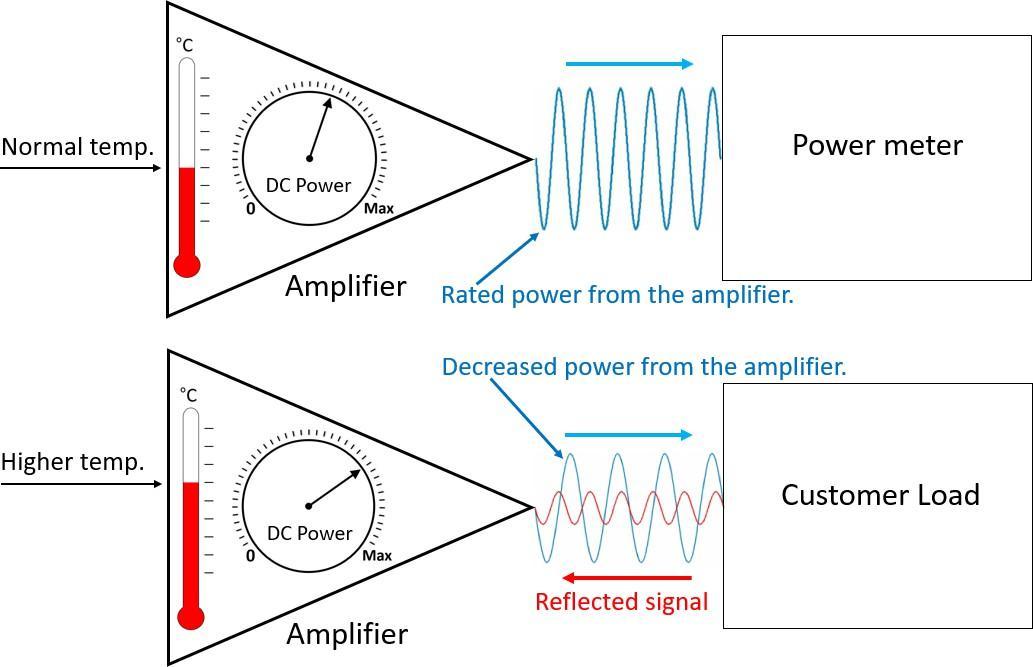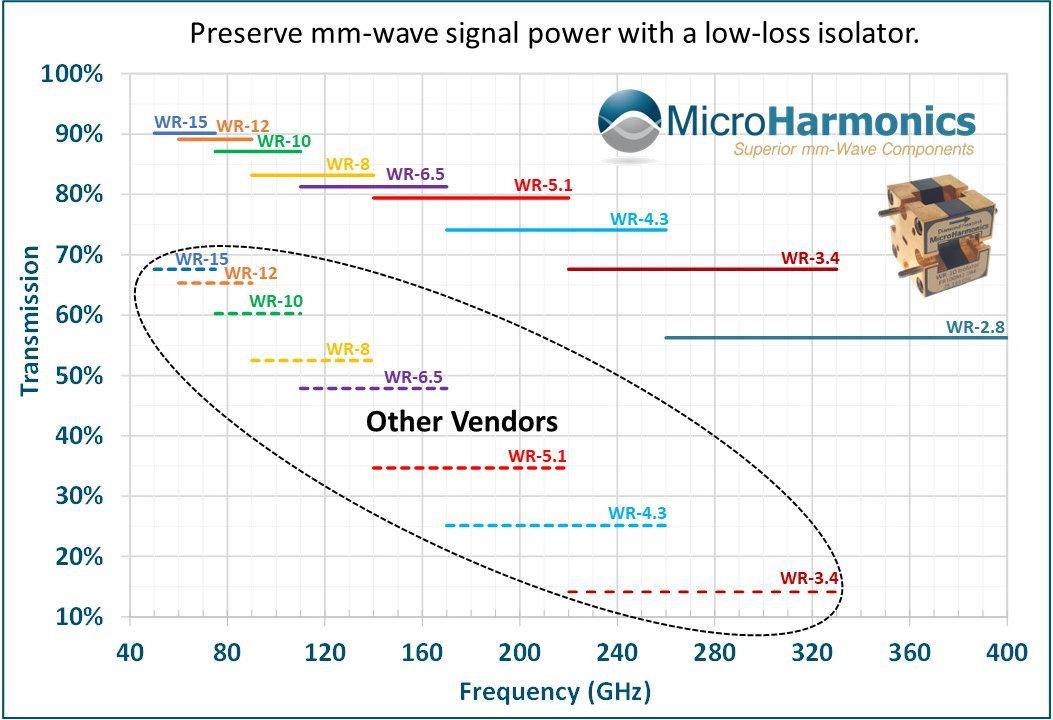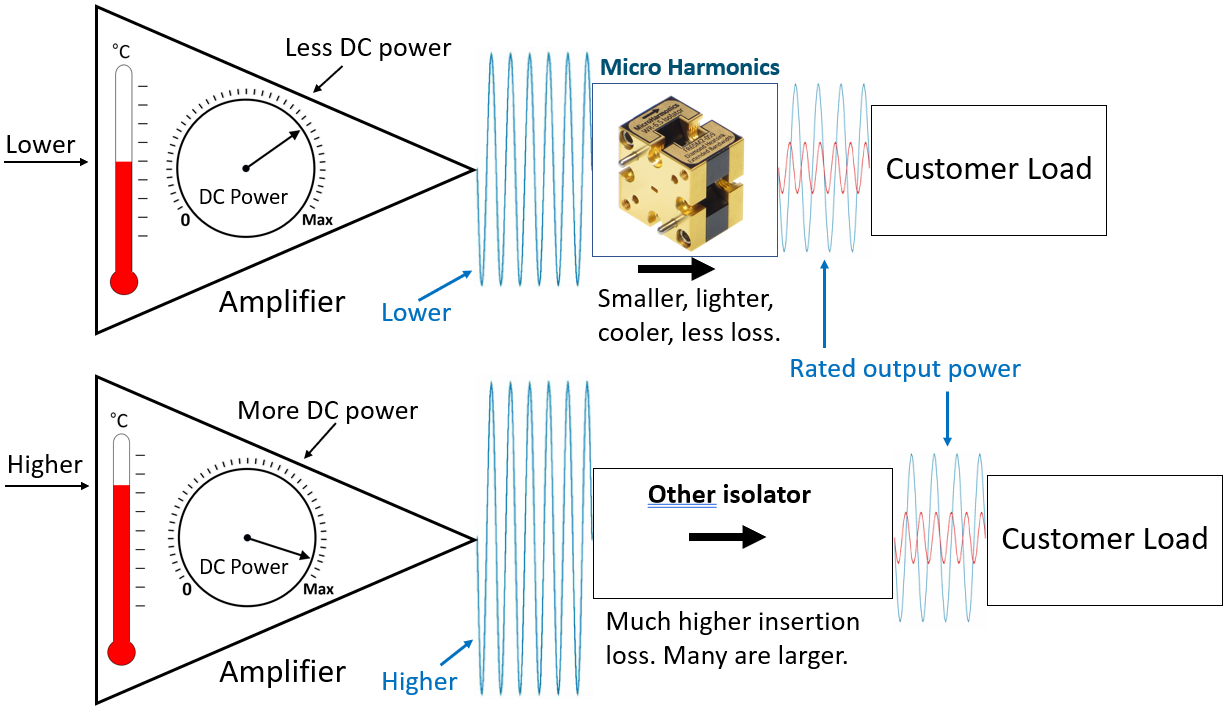Do mm-Wave Power Amplifiers Need Isolators?
The answer to the question is often yes. It is common to see a mm-wave power amplifier with an isolator attached to the output port. The reason may have less to do with the impedance matching of the amplifier and more with the impedance matching of the load. The amplifier may perform well when connected to a well-matched load such as a power meter. However, the performance may be degraded when the load is not well-matched.
Manufacturers often attach an isolator to the output because they have no control over the impedance match of the customer’s system.
Figure 1 gives an illustration of the problem. When the amplifier is tested at the factory using a power meter, it demonstrates good RF output power over the tested band. It is measured to have a normal operating temperature and draws a specified amount of DC power. However, the performance degrades when the customer purchases the amplifier and attaches it to their system. An impedance mismatch causes part of the signal to be reflected back toward the amplifier. The amplifier absorbs part of the reflected signal, which alters its operating point. This can result in reduced output power, increased operating temperature, and an increased draw from the DC power supplies.
Figure 1 – An amplifier with two different loads. In the top graphic, the load is well-matched over a broad bandwidth (a power meter is a good example). The bottom graphic shows the same amplifier connected to an arbitrary customer load which may vary broadly from one system to the next. The result is often a reflected wave that is partially absorbed in the amplifier output, altering the operating point and resulting in higher operating temperatures and reduced output power.
The obvious solution is to add an isolator to the amplifier output port. This ensures that the amplifier sees a well-matched load regardless of any signal reflected from the customer load. Figure 2 shows the isolator between the amplifier and the customer load. Isolators have insertion loss, so in order to deliver the desired rated power to the customer load, the amplifier output power must be increased. This also results in a higher operating temperature, but the amplifier operating point is now steady over broad bandwidths.
Figure 2 – Amplifier with an isolator on the output.
An important consideration is the insertion loss of the isolator. At higher mm-wave bands, isolators sold by other vendors have been notorious for having high insertion loss. For example, an isolator operating in the D-band (WR-6.5, 110-170 GHz) can have an insertion loss well in excess of 3 dB, as indicated in Figure 3.
Figure 3 – Comparison of insertion loss for Micro Harmonics isolators versus other isolators.
Fortunately, Micro Harmonics has developed a line of Faraday rotation isolators with exceptionally low insertion loss, the lowest by far of any isolator on the commercial market. Our D-band isolator has an insertion loss of less than 0.9 dB, which means it passes more than 82% of the signal in the forward direction. Our isolators also have integral diamond heat spreaders which allow for much higher maximum power ratings, perfect for pairing with amplifiers.
Why Is It Important to Use a Micro Harmonics Isolator on Your Amplifier?
Consider the graphic in Figure 4. Using the lower loss Micro Harmonics isolator means that the amplifier will run at a cooler operating temperature, require less DC power, and the overall system size will be smaller. Using a higher loss isolator from another vendor means that the amplifier power will have to be turned up, resulting in higher operating temperatures and more DC power consumption.
Figure 4 – The impact of using a Micro Harmonics isolator with your amplifier.
What if Your Amplifier Has Plenty of Power to Spare?
Can’t you just turn up the amplifier until you overcome the isolator insertion loss? Perhaps, but there are costs to this approach. High operating temperatures equate to a lower meantime to failure. Your amplifier (and your system) will have a shorter lifetime. The rated power of other isolators is far less than the rated power of Micro Harmonics isolators. The diamond heat spreader used in the Micro Harmonics isolator means that the internal temperatures inside the isolator are much lower at any given power level than temperatures inside the other isolators.
This has been verified through sophisticated thermal models. This, again, means higher reliability. Also, driving the amplifier hard may lead to signal distortion and unwanted harmonic content. Lastly, the Micro Harmonics isolators are the smallest and lightest-weight isolators on the market, making your system more compact.
We made a video on this topic called “Using an Isolator on the Output of Your MMW System”. You can find it here.




